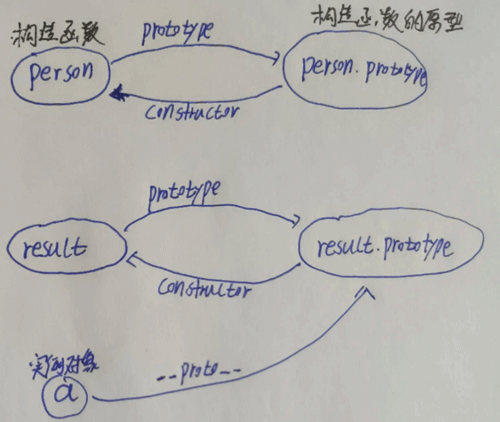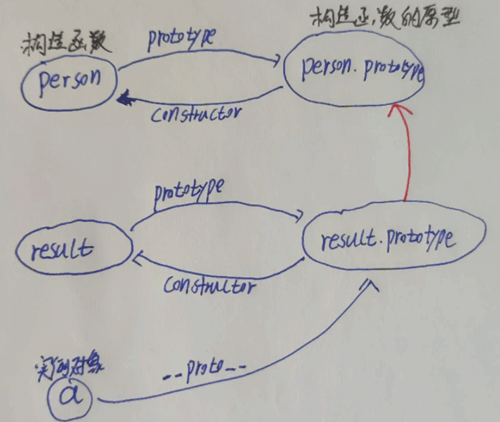对象context想调用一个它没有的方法f 怎么办呢?f.call(context) 通过call来借用方法f ,怎么做到的呢?
Function.prototype.myCall = function(context, ...arg) {
// 如果第一个参数传入的是undefined和null,context为window对象
context = context || window;
// 为context对象添加函数bar
context.fn = this; // this:bar,this指向调用myCall的bar
// context对象执行函数bar,并返回结果
return context.fn(...arg);
}
// 测试一下
var value = 2;
var obj = {
value: 1
}
function bar(name, age) {
console.log(this.value);
return {
value: this.value,
name: name,
age: age
}
}
bar.myCall(null); // 2
console.log(bar.myCall(obj, 'kevin', 18)); //1
// Object {
// value: 1,
// name: 'kevin',
// age: 18
// }apply和call唯一的区别是:call传入的是参数列表,apply传入的是数组,也可以是类数组
Function.prototype.myApply = function(context, arg) {
// 如果第一个参数传入的是undefined和null,context为window对象
context = context || window;
// context对象添加函数bar
context.fn = this; // this:bar,this指向调用myCall的函数bar
// context对象执行函数bar,并返回结果
let result = null;
if (!arg) { // 没有传入数组
result = context.fn();
}else{ // 传入了参数数组
result = context.fn(...arg);
}
return result;
}
// 测试一下
var value = 2;
var obj = {
value: 1
}
function bar(name, age) {
console.log(this.value);
return {
value: this.value,
name: name,
age: age
}
}
bar.myApply(null); // 2
console.log(bar.myApply(obj, ['kevin', 18])); // 1bind实现最为复杂,因为经过bind绑定过的函数,既可以被当作普通函数调用,又可以被当作构造函数调用
// bind 返回的函数 作为普通函数调用
let bindFun = normalFun.myBind(obj, '我是参数传进来的name') // this:obj
bindFun('我是参数传进来的age')// bind 返回的函数 作为构造函数调用
let bindFun = Person.myBind(obj, '我是参数传进来的name') // this:obj
let a = new bindFun('我是参数传进来的age') // this:a// bind 返回的函数 作为普通函数调用
Function.prototype.myBind = function (context, ...args){
// 如果第一个参数传入的是undefined和null,context为window对象
context = context || window;
// context对象(obj)添加函数normalFun
context.fn = this; // this:normalFun, context.fn === normalFun,下面出现context.fn都可以直接看成normalFun
// bind返回的函数
return function (...innerArgs) {
// bind 返回的函数 作为普通函数被执行
context.fn(...[...args,...innerArgs]); //相当于normalFun(...[...args,...innerArgs])
}
}
// 测试
let obj = {
objName: '我是obj传进来的name',
objAge: '我是obj传进来的age'
}
// 普通函数
function normalFun(name, age) {
console.log(name); //'我是第一次参数传进来的name被args接收'
console.log(age); //'我是第二次参数传进来的age被innerArgs接收'
console.log(this === obj); // true,this指向obj
console.log(this.objName); //'我是obj传进来的name'
console.log(this.objAge); //'我是obj传进来的age'
}
// bind 返回的函数 作为普通函数调用
let bindFun = normalFun.myBind(obj, '我是第一次参数传进来的name被args接收'); // this指向obj
bindFun('我是第二次参数传进来的age被innerArgs接收'); // bind 返回的函数 再经过new调用
Function.prototype.myBind = function (context, ...args){
// 如果第一个参数传入的是undefined和null,context为window对象
context = context || window;
// context对象添加函数Person
context.fn = this; // this:Person,context.fn:Person,_this:Person
let _this = this;
// bind返回的函数
const result = function (...innerArgs) {
if (this instanceof _this ) { // this:a (new出来的实例对象) , _this:Person
// 为实例对象a添加Person方法
this.fn = _this;
// 实例对象a执行Person方法
this.fn(...[...args,...innerArgs]);
}
}
result.prototype = Object.create(this.prototype); // 为什加这一句?看原型图下面会解释
return result;
}
// 测试
function Person(name, age) {
console.log(name); //'我是第一次参数传进来的name被args接收'
console.log(age); //'我是第二次参数传进来的age被innerArgs接收'
console.log(this); //构造函数this指向实例对象
}
// 构造函数原型的方法
Person.prototype.say = function() {
console.log(123);
}
let obj = {
objName: '我是obj传进来的name',
objAge: '我是obj传进来的age'
}
// bind 返回的函数 作为构造函数调用
let bindFun = Person.myBind(obj, '我是第一次参数传进来的name被args接收') // this:obj
let a = new bindFun('我是第二次参数传进来的age被innerArgs接收') // this:a
a.say() //123画以下两条语句的原型图方便理解
let bindFun = Person.myBind(obj, '我是第一次参数传进来的name被args接收') // this:obj
let a = new bindFun('我是第二次参数传进来的age被innerArgs接收') // this:a当执行下面语句时,原型图如下:
let bindFun = Person.myBind(obj, '我是第一次参数传进来的name被args接收') // this:obj

当执行下面语句时,bindFun就是result看代码,原型图如下:
let a = new bindFun('我是第二次参数传进来的age被innerArgs接收') // this:a
在这里实例对象a还需要继承构造函数Person的原型,所以加上了
result.prototype = Object.create(this.prototype);
原型图最终如下:

Function.prototype.myBind = function (context, ...args){
// 如果第一个参数传入的是undefined和null,context为window对象
context = context || window;
// context对象添加函数Person
context.fn = this; // this:Person,context.fn:Person,_this:Person
let _this = this;
// bind返回的函数
const result = function (...innerArgs) {
if (this instanceof _this ) { // this:a (new出来的实例对象) , _this:Person
// 为实例对象a添加Person方法
this.fn = _this;
// 实例对象a执行Person方法
this.fn(...[...args,...innerArgs]);
}else{
// 普通函数被调用
context.fn(...[...args,...innerArgs]);
}
}
result.prototype = Object.create(this.prototype); // 为什加这一句?看原型图下面会解释
return result;
}
// 测试
// function Person(name, age) {
// console.log(name); //'我是第一次参数传进来的name被args接收'
// console.log(age); //'我是第二次参数传进来的age被innerArgs接收'
// console.log(this); //构造函数this指向实例对象
// }
// // 构造函数原型的方法
// Person.prototype.say = function() {
// console.log(123);
// }
// let obj = {
// objName: '我是obj传进来的name',
// objAge: '我是obj传进来的age'
// }
// // bind 返回的函数 作为构造函数调用
// let bindFun = Person.myBind(obj, '我是第一次参数传进来的name被args接收') // this:obj
// let a = new bindFun('我是第二次参数传进来的age被innerArgs接收') // this:a
// a.say() //123
// 测试
let obj = {
objName: '我是obj传进来的name',
objAge: '我是obj传进来的age'
}
// 普通函数
function normalFun(name, age) {
console.log(name); //'我是第一次参数传进来的name'
console.log(age); //'我是第二次参数传进来的age'
console.log(this === obj); // true
console.log(this.objName); //'我是obj传进来的name'
console.log(this.objAge); //'我是obj传进来的age'
}
// bind 返回的函数 作为普通函数调用
let bindFun = normalFun.myBind(obj, '我是第一次参数传进来的name被args接收'); // this指向obj
bindFun('我是第二次参数传进来的age被innerArgs接收');